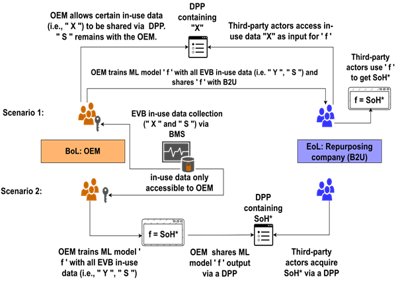In a recent study by the Christian Doppler Laboratory for Sustainable Product Management, co-funded by iPoint Systems, different digital methods were explored for preserving confidentiality in data exchange along value chains. The study focused on cryptographic and statistical approaches and the potential of Probabilistic Machine Learning in the context of data from sustainable product management and digital product passports.
The Role and Importance of Confidential Information in Sustainable Product Management
To enable sustainable product management (SPM), product life cycle data play a significant role. Such data are, for instance, the pre-requisite to conduct Life Cycle Assessments and are further handled as the critical component of Digital Product Passports (DPPs). Such passports can be valuable SPM decision support tools, as they may function as product life cycle data carriers. Consequently, a DPP could provide valuable insights into a product's lifecycle, enabling businesses to conduct more sustainable and circular operations. However, product life cycle data are often characterized by sensitivity, resulting in stakeholders’ reluctance to share crucial data. This poses significant challenges to the full potential of DPPs in supporting SPM. Therefore, confidentiality-preserving data exchange is of importance in this context.
Different Approaches to Confidentiality-Preserving Data Exchange
To address the issue of data sensitivity, several cryptographic and machine-learning approaches can be employed to ensure confidentiality-preserving data exchange. These approaches can be broadly categorized into cryptographic and statistical methods.
Cryptographic approaches such as homomorphic encryption, multiparty computation, and zero-knowledge proofs provide cryptographic guarantees of confidentiality. They ensure that sensitive information is only accessible to designated parties, encouraging stakeholders to share crucial data without fear of being misused.
On the other hand, statistical approaches like federated learning, differential privacy, and invariant/fair learning provide statistical guarantees of confidentiality. They ensure that confidentiality holds with a specified probability, even when dealing with large amounts of data. These methods can be used to obtain data or models from which statistical relationships have been removed, thus preserving the privacy of sensitive information.
It needs to be noted that the deployment of either cryptographic or statistical approaches depends on the SPM use case at hand.
Potential of Model Sharing in Confidentiality-Preserving Data Exchange
As shown in Figure 1, the paper introduces a concept of model sharing for confidentiality-preserving data exchange via a DPP. The specific use case concerns sharing Electric Vehicle Battery (EVB) in-use data. Such data is required to enable Battery Second Use (B2U) business models while being attributed with high sensitivity by the Original Equipment Manufacturer (OEM). The proposed concept illustrates EVB in-use data sharing between an OEM and a third-party actor that pursues a B2U business model based on two scenarios:
- In the first scenario, an OEM shares a machine-learning model with the B2U actor. This model was trained based on all the available EVB in-use data and is designed to reveal minimal information about the sensitive in-use data parts. The OEM then further shares the non-sensitive parts of the in-use data via a DPP. This non-sensitive in-use data serves as input for the machine learning model, enabling the third party to calculate an approximation of the state of health (SoH) of the EVB. This enables the third-party actor to support decision situations in a B2U context.
- The second scenario presents a situation where the OEM maintains even tighter control over the sensitive data. Instead of sharing the machine learning model itself, the OEM only communicates the output of this model via the DPP. This means that B2U actors receive the necessary information about the EVB's SoH without having any access to the in-use data or the specifics of the model that generated this information. This method provides a higher level of confidentiality, as the OEM keeps full control over the sensitive data and the machine learning model.
The choice between the two scenarios would depend on the level of confidentiality required and the trust relationship between the OEM and other stakeholders.

Figure 1: Two potential scenarios of how model sharing could be deployed for confidentiality-preserving data exchange via a digital product passport (DPP).
Conclusion
In conclusion, deploying data science and machine learning approaches for confidentiality-preserving data exchange holds promise for SPM. Thus, further research of the CD-Laboratory and iPoint -systems is focused on demonstrating the potential in other use cases in the context of DPPs and Life Cycle Assessment.
Open access to the full study
This study was published in Procedia CIRP and the full paper „Confidentiality-preserving data exchange to enable sustainable product management via digital product passports – a conceptualization” by Katharina Berger, Magdalena Rusch, Antonia Pohlmann, Martin Popowicz, Bernhard C. Geiger, Heimo Gursch, Josef-Peter Schöggl and Rupert J. Baumgartner can be read here: https://doi.org/10.1016/j.procir.2023.02.060.




.png)

